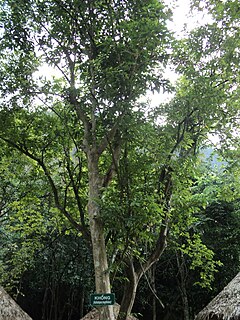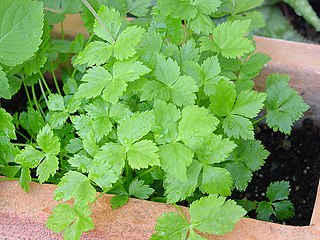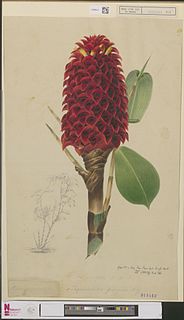Paracroton is a genus of flowering plants in the Euphorbiaceae first described as a genus in 1859. It is native to South and Southeast Asia, as well as New Guinea.
- Paracroton integrifolius(Airy Shaw) N.P.Balakr. & Chakr. - Kerala, Tamil Nadu
- Paracroton pendulus(Hassk.) Miq. - India, Sri Lanka, Myanmar, Thailand, Malaysia, Borneo, Sumatra, Philippines
- Paracroton sterrhopodus(Airy Shaw) Radcl.-Sm. & Govaerts - W New Guinea
- Paracroton zeylanicus(Müll.Arg.) N.P.Balakr. & Chakr. - Sri Lanka

Koilodepas is a genus of plant of the family Euphorbiaceae first described as a genus in 1856. It is native to Southeast Asia, India, Hainan, and New Guinea.

Cryptotaenia, also honewort, is a genus of herbaceous perennial plants, native to North America, Africa, and eastern Asia, growing wild in moist, shady places.
Pimelodendron is a plant genus in the family Euphorbiaceae first described as a genus in 1855. It is native to insular Southeast Asia, Thailand, Papuasia, and Queensland.

Cyanotis is a genus of mainly perennial plants in the family Commelinaceae, first described in 1825. It is native to Africa, southern Asia, and northern Australia.
- Cyanotis adscendensDalzell - India, Sri Lanka
- Cyanotis ake-assiiBrenan - Mali, Ivory Coast
- Cyanotis angustaC.B.Clarke - West Africa
- Cyanotis arachnoideaC.B.Clarke - tropical Africa, Indian Subcontinent, southern China, Indochina
- Cyanotis arcotensisR.S.Rao - southern India
- Cyanotis axillaris(L.) D.Don ex Sweet - Indian Subcontinent, southern China, Southeast Asia, Northern Australia
- Cyanotis beddomei(Hook.f.) Erhardt, Götz & Seybold - southern India
- Cyanotis burmannianaWight - India, Sri Lanka, Myanmar
- Cyanotis caespitosaKotschy & Peyr. - tropical Africa
- Cyanotis cerifoliaR.S.Rao & Kammathy - southern India
- Cyanotis ceylanicaHassk. - Sri Lanka
- Cyanotis cristata(L.) D.Don - Indian Subcontinent, southern China, Southeast Asia, Ethiopia, Socotra, Mauritius, Java, Philippines
- Cyanotis cucullata(Roth) Kunth - southern India, Myanmar, Thailand
- Cyanotis cupricolaJ.Duvign. - Zaïre
- Cyanotis dybowskiiHua - Congo-Brazzaville, Central African Republic
- Cyanotis fasciculata(B.Heyne ex Roth) Schult. & Schult.f. - Indian Subcontinent
- Cyanotis flexuosaC.B.Clarke - Huíla region of Angola
- Cyanotis foecundaDC. ex Hassk - central + eastern Africa, Yemen
- Cyanotis ganganensisSchnell - Guinea
- Cyanotis grandidieriH.Perrier - Madagascar
- Cyanotis hepperiBrenan - Nigeria
- Cyanotis hombleiDe Wild. - Zaïre
- Cyanotis karlianaHassk. - southern India
- Cyanotis lanataBenth. - tropical + southern Africa, Yemen
- Cyanotis lapidosaPhil. - South Africa, Swaziland
- Cyanotis longifoliaBenth. - tropical Africa
- Cyanotis loureiroana(Schult. & Schult.f.) Merr - Guangdong, Hainan, Vietnam
- Cyanotis lourensisSchnell - Guinea
- Cyanotis nilagiricaHassk. - southern India
- Cyanotis nyctitropaDeflers - Yemen, Saudi Arabia
- Cyanotis obtusa(Trimen) Trimen - southern India, Sri Lanka
- Cyanotis pachyrrhizaOberm. - Transvaal
- Cyanotis paludosaBrenan - Zaïre, Kenya, Uganda, Tanzania
- Cyanotis papilionacea(Burm.f.) Schult. & Schult.f. - southern India
- Cyanotis pedunculataMerr. - Leyte Island in Philippines
- Cyanotis pilosaSchult. & Schult.f. - southern India, Sri Lanka
- Cyanotis polyrrhizaHochst. ex Hassk. - Ethiopia
- Cyanotis racemosaB.Heyne ex Hassk. - southern India, Sri Lanka
- Cyanotis repensFaden & D.M.Cameron - Zaïre, Kenya, Rwanda, Tanzania, Gabon
- Cyanotis reutianaBeauverd - southern India
- Cyanotis robustaOberm. - Transvaal, Namibia
- Cyanotis scaberulaHutch. - Guinea
- Cyanotis somaliensisC.B.Clarke - Somalia
- Cyanotis speciosa(L. f.) Hassk. - central + southern Africa, Madagascar
- Cyanotis thwaitesiiHassk. - India, Sri Lanka, Myanmar
- Cyanotis tuberosa(Roxb.) Schult. & Schult.f. - western India
- Cyanotis vaga(Lour.) Schult. & Schult.f. - tropical Africa, Yemen, Himalayas, southern China, Indochina, Java
- Cyanotis vaginataWight - southern India
- Cyanotis villosa(Spreng.) Schult. & Schult.f. - southern India, Sri Lanka

Barringtonia is a genus of flowering plants in the family Lecythidaceae first described as a genus with this name in 1775. It is native to Africa, southern Asia, Australia, and various islands of the Pacific and Indian Oceans. The genus name commemorates Daines Barrington.

Floscopa is a genus of plant in family Commelinaceae first described in 1790. It is widespread in tropical + subtropical areas: Africa, Madagascar, the Indian Subcontinent, Southeast Asia, China, Queensland, Central + South America.
- Floscopa africana(P.Beauv.) C.B.Clarke - from Liberia east to Uganda
- Floscopa aquaticaHua - from Sierra Leone + Mali east to Gabon
- Floscopa axillaris(Poir.) C.B.Clarke - West Africa from Senegal to Benin
- Floscopa confusaBrenan - from Ivory Coast to Tanzania
- Floscopa elegansHuber - Ecuador, Peru, northwestern Brazil
- Floscopa flavidaC.B.Clarke - from Senegal to Tanzania and south to Botswana
- Floscopa glabrata(Kunth) Hassk. - Brazil, Paraguay, Argentina, Bolivia, Colombia, Costa Rica; naturalized in Vietnam
- Floscopa glomerata(Willd. ex Schult. & Schult.f.) Hassk. - most of sub-Saharan Africa; Madagascar
- Floscopa gossweileriCavaco - Angola
- Floscopa leiothyrsaBrenan - Mali, Chad, Zaïre, Tanzania, Zambia, Botswana
- Floscopa mannii C.B.Clarke - from Nigeria to Zaïre
- Floscopa perforansRusby - Bolivia
- Floscopa peruvianaHassk. ex C.B.Clarke - Bolivia, Peru, Ecuador, Venezuela, Suriname, French Guinea
- Floscopa polypleuraBrenan - Ghana, Tanzania, Zambia
- Floscopa rivularioidesT.C.E.Fr. - Zimbabwe
- Floscopa robusta(Seub.) C.B.Clarke - Brazil, Colombia, Ecuador, Peru, Central America
- Floscopa scandensLour. - China, Indian Subcontinent, Andaman & Nicobar Islands, Indochina, Malaysia, western Indonesia, Philippines, Queensland
- Floscopa schweinfurthiiC.B.Clarke - Tanzania
- Floscopa tanneriBrenan - Zaïre, Tanzania
- Floscopa yunnanensisD.Y.Hong - Yunnan Province in China

Cardiopteridaceae is a eudicot family of flowering plants. It consists of about 43 species of trees, shrubs, and woody vines, mostly of the tropics, but with a few in temperate regions. It contains six genera, the largest of which is Citronella, with 21 species. The other genera are much smaller.

Rhodomyrtus is a group of shrubs and trees in the family Myrtaceae described as a genus in 1841. The genus is native to southern China, the Indian Subcontinent, Southeast Asia, Melanesia, and Australia.

Scindapsus is a genus of flowering plants in the family Araceae. It is native to Southeast Asia, New Guinea, Queensland, and a few western Pacific islands.

Cyrtosperma is a genus of flowering plants in the Araceae family. The genus went through considerable taxonomic changes in the 1980s, and as a result is now considered to be native only to Southeast Asia and some Pacific islands. Previously, the genus was believed to be widespread from Asia to Africa and South America, but the African and South American species were subsequently moved into separate genera. Cyrtosperma is now known to be most prominent in New Guinea. The genus Cyrtosperma is unique in this regards because it is the only known big genus in Araceae that is known to be found east of Wallace's line.

Justus Carl Hasskarl was a German explorer and botanist specializing in Pteridophytes, Bryophytes and Spermatophytes. He was co-founder of the Society of Natural Curiosities of India, in Bavaria and spent his time researching flora of Indonesia for years.

Murdannia is a genus of annual or perennial monocotyledonous flowering plants in the dayflower family.

Amischotolype is a genus of perennial monocotyledonous flowering plants in the dayflower family. It is found in Central Africa and from India through Southeast Asia to New Guinea, with the great majority or species found in Asia.

Pollia is a genus of flowering plants in the Commelinaceae, first described in 1781. It is widespread through the Old World Tropics: Africa, southern Asia, northern Australia, etc. There is also one species endemic to Panama.
- Pollia americanaFaden - Panama
- Pollia bracteataK.Schum. - Tanzania
- Pollia condensataC.B.Clarke - much of tropical Africa
- Pollia crispata(R.Br.) Benth. - Queensland, New South Wales
- Pollia gracilisC.B.Clarke - Comoros, Madagascar
- Pollia hasskarliiR.S.Rao - southern China, Himalayas, Indochina, Peninsular Malaysia, Java
- Pollia × horsfieldiiC.B.Clarke - Java (P. secundiflora × P. thyrsiflora)
- Pollia japonicaThunb. - China, Japan, Korea, Taiwan, Vietnam
- Pollia macrobracteataD.Y.Hong - Guangxi
- Pollia macrophylla(R.Br.) Benth. - Queensland, New Guinea, Solomon Islands, Philippines, Vietnam
- Pollia manniiC.B.Clarke - from Ivory Coast to Tanzania + Angola
- Pollia miranda(H.Lév.) H.Hara - China, Japan, Ryukyu Islands, Taiwan
- Pollia papuanaRidl. - New Guinea
- Pollia pentaspermaC.B.Clarke - Assam
- Pollia sambiranensisH.Perrier - Madagascar
- Pollia secundiflora(Blume) Bakh.f. - China, Taiwan, Ryukyu Islands, Indian Subcontinent, Southeast Asia, New Guinea, New Caledonia
- Pollia subumbellataC.B.Clarke - southern China, Himalayas, Peninsular Malaysia
- Pollia sumatranaHassk. - Peninsular Malaysia, Borneo, Sumatra, Philippines
- Pollia thyrsiflora(Blume) Steud. - southern China, Assam, Southeast Asia
- Pollia verticillataHallier f. - New Guinea
- Pollia × zollingeri(Hassk.) C.B.Clarke - Java (P. hasskarlii × P. secundiflora)
Blyxa is a genus of an aquatic plant of the family Hydrocharitaceae described as a genus in 1806.

Belosynapsis is a genus of mainly perennial plants in the family Commelinaceae, first described in 1871. It is native to Southeast Asia, the Indian Subcontinent, Papuasia, and southern China.
- Belosynapsis ciliata(Blume) R.S.Rao - southern China, eastern Himalayas, Indochina, Malaysia, Indonesia, Philippines, New Guinea, Solomon Islands, Vanuatu
- Belosynapsis epiphytica(Blatt.) C.E.C.Fisch. - southern India
- Belosynapsis kawakamii(Hayata) C.I.Peng & Y.J.Chen - Taiwan
- Belosynapsis kewensisHassk. - southern India
- Belosynapsis moluccana(Roxb.) C.E.C.Fisch. - Malaysia, Indonesia, Philippines, New Guinea
- Belosynapsis vivipara(Dalzell) C.E.C.Fisch. - southern India

Tapeinochilos is a group of plants in the Costaceae described as a genus in 1869. It is native to Queensland, Papuasia, and the Indonesian Province of Maluku.

Chlorophytum laxum is a flowering plant species in the genus Chlorophytum, widespread through tropical Africa, Asia, and Australia.



















